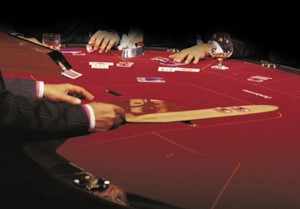Chemin de fer is a game very similar to Baccarat for scores and cards, but differs as regards the conduct of the game. The players, usually eight, are arranged in a circle along the table; the sense of the game is counterclockwise. A player usually is the dealer and the player behind him is the challenger (tip). The bank passes from player to player as one who has lost the shot.
Rules of the Game
Chemin de fer is played with 6 decks of 52 cards each, called “cut”.The dealer puts the figure who wants to play close to the sabot, and the player who takes the cards can bet the whole sum or part of the sum, leaving the other players can bet as long as the amount determined by the counter is reached (coverage of the bench). Where there is partial betting, a player may decide to beat the dealer, or play the whole figure suggested by the dealer, players that have made partial bets must withdraw their bets. At the discretion of the point which he called “bank” can “meet” the bets of other players. If two players want to ‘beat’ the bench, he has precedence before the turn counterclockwise and the player may “hurt”. The dealer total (alternately) gives two cards to the opponent and two cards to himself.
If the challenger wins, then the amount the bank will be up to him, continuing the sense of play, If the dealer wins, he may:
- Continue to play, leaving the mail (which has doubled since the previous round minus the cagnotte)
- Halving the mail, only by round 3 (the third consecutive wins).
- Declare “there is a sequel” or withdraw and retain for itself the amount of the bank accumulated until that moment, in which case the bank is auctioned.
If a bank loses obtained through the auction, the round begins with the player to the right of the player who had retired (regular hand). The Casino, with each round won by the bank, holding back a percentage called “cagnotte” (usually 5%).
























